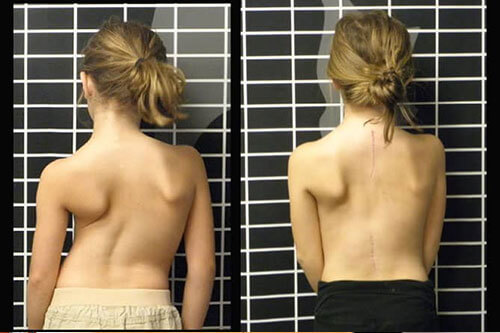Scoliosis

A scoliosis brace is a device worn around the torso that can help prevent the curve from getting worse. It can also make it less likely that you’ll need surgery in the future after bone growth has stopped.
A brace is the only available treatment that can potentially slow the progression of the curve in a child or adolescent whose bones are still growing. It does not work after bone growth has stopped.
How does bracing work?
Rigid braces put pressure on your spine in several places to help prevent it from curving more than it already has. Dynamic braces slow curve progression by retraining your body into maintaining a corrective posture.
Types of braces
1. Boston Brace (Full time brace)
A Boston brace is typically made from one of several prefabricated mold options. After the orthotist (the person making the brace) selects the mold that best fits the patient’s size and curve type, corrective pads and trim lines (cut-outs) are strategically added to the brace by following a blueprint specific to the patient’s scoliosis curve.
The Boston brace works by applying corrective pressure on the convex (outer) side of the curve and cutting out corresponding areas of relief on the concave (inner) side of the curve so the spine can migrate in that direction.
The brace opens in the back, so the patient may need help getting into and out of it.
2. Wilmington Brace (Full time brace)
Another common TLSO is the Wilmington brace. However, unlike the Boston brace, the Wilmington brace is custom-fitted based on a cast taken of the patient while lying down, facing up. After the cast is made, corrective forces specific to the patient’s spinal curve are added before the brace is completed.
This brace goes onto the body similar to a tight jacket and is known as a full-contact TLSO due to its lack of gaps or open spots.
3. Milwaukee Brace (Full time brace)
The Milwaukee brace, which is the original cervico-thoracic-lumbar-sacral orthosis (CTLSO) invented in the 1940s, is an older and bulkier brace. Due to the effectiveness and relative convenience of today’s more modern braces, the Milwaukee brace is rarely used anymore. However, it is still sometimes used for curves higher in the thoracic or cervical spine.
4. Charleston Bending Brace (Night time brace)
This is the most prescribed nighttime brace. It’s a TLSO that’s custom-made to fit your body and spinal curve. It puts strong pressure on your spine, bending it past the midline of your back. This overcorrection is only possible while you’re lying down.
5. Rigo-Chêneau Brace
A 3D-printed brace made to custom-fit the patient, the Rigo-Chêneau Brace is made of rigid plastic that encases the torso. It opens in the front to allow children more independence by being able to take it off and put in on their own. The plastic parts are customizable, so you can change the color.
6. The SpineCor Brace
No hard plastic is used to make the SpineCor Brace. It offers the most flexibility, and it is customized for each child.

